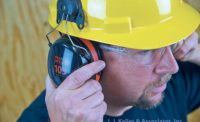Is this the most efficient way to operate a facility? Lower productivity due to high noise is a significant hidden cost in industrial plants.
Sounds that matter
Just as drivers get used to the normal sound of their cars, workers pick up audible cues from their equipment to determine if it is working properly. Drivers instinctively turn down their radios in their cars when they hear a RdifferentU sound so they can locate where it is coming from and can fix the problem before it gets any worse.High noise in the workplace cannot be shut down for workers to properly listen to the operation of their equipment. A recent project at a tube mill focused noise control on an exhaust duct leading from a pre-heat furnace. The controls were installed over the weekend. When the production superintendent came to work on Monday morning he was upset because he thought the equipment was not operating due to maintenance or production problems, only to learn that noise controls were so effective that the roar of the exhaust gases had been eliminated.
Workers at the control console can now communicate comfortably. They can hear the operation of their equipment, masked earlier by the noise from the exhaust ducting. They can also hear if a fault is developing, possibly the onset of a bad bearing or an inconsistency in the operating process. Only now is the benefit of lower noise obvious. It has provided a more productive work environment.
Why cut down on profits?
Another case really drives the point home. A noise control analysis of a fabricating facility was being conducted to determine methods to minimize noise generation. Line speed of the equipment in question was 350 feet per minute, yet when discussing noise control options with the plant engineer, it was found that the design speed of the line was actually 450 feet per minute. Why were they operating the equipment below the most profitable speed? Noise at 450 feet per minute was so loud that workers in the plant complained. They found that at 350 feet per minute the noise level was acceptable! The offending gearbox was controlled and the equipment was allowed to operate at its optimum speed. Lower noise yielded significant productivity gains.The easy fix
How about the Reasy fixU: making the use of hearing protection mandatory when noise levels exceed 85 decibels, to meet OSHA requirements. It only makes matters worse. DonUt believe it? I recently spoke at a workshop on Hearing Conservation conducted by PittsburghUs Dr. Roger Angelelli. I asked the safety and medical professionals present, what happens when they try to talk to workers wearing hearing protection in high noise. They agreed that workers will often remove their ear plugs or ear muff so they can communicate. If they must remove ear protectors to hear conversations, how can they function effectively in their work environment?So where do we go from here? High noise exists in most industrial plants. And workers must wear ear protection to reduce the risk of hearing loss. What about reducing workplace noise? Sounds like an idea that fits well into the model of a lower cost, higher productivity work environment. Everyone gains. Better worker communication, better maintained equipment, reduced workersU compensation liability, lower worker stress, fewer lost work days, higher profits, healthier and safer workplaces. A win-win solution.
Stephen I. Roth, P.E. is president of Roth Acoustical Associates in Upper St. Clair, Pa. He can be reached at: (412) 831-8382; or via e-mail at: sroth@rothacoustics.com. Internet: www.rothacoustics.com.
